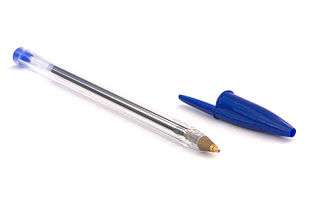Bic Cristal


The Bic Cristal (also known as the Bic pen) is an inexpensive disposable ballpoint pen mass-produced and sold by Société Bic of Clichy, Hauts-de-Seine, France.
Background
In 1945 after the Second World War, Marcel Bich and Edouard Buffard founded Société PPA (the French acronym standing for "pens, mechanical pencils and accessories") in Clichy, a suburb north of Paris. During the war Bich had seen a ballpoint pen manufactured in Argentina by László Bíró. Between 1949 and 1950 the Bic Cristal was designed by the Décolletage Plastique design team at Société PPA (later Société Bic).[1][2] Bich invested in Swiss technology capable of cutting and shaping metal down to 0.01 millimetres (0.00039 in), with the outcome a stainless steel, one-millimetre (0.039 in) sphere which allowed ink to flow freely. Bich developed a viscosity of ink which neither leaked nor clogged and, under a licence from Bíró, launched the Cristal in December 1950.[1]
Bich invested heavily in advertising, hiring poster designer Raymond Savignac. In 1953 advertising executive Pierre Guichenné advised Bich to shorten his family name to Bic as an easy-to-remember, globally adaptable tradename for the pen, which fit in with product branding trends of the post-war era.[1] Called the "Atomic pen" in France, throughout the 1950s and 1960s the Bic Cristal's ballpoint writing tip and ergonomic design helped change the worldwide market for pens from fountain pens to mostly ballpoints.
In 1959 Bich brought the pen to the American market: the Bic pen was soon selling at 29 cents (equivalent to $2.36 in 2015) with the slogan "writes first time, every time."[3] In 1965 the French ministry of education began allowing the use of ballpoint pens in classrooms.
The Bic Cristal is the best selling pen in the world; the 100 billionth was sold in September 2006.[4]
Design
The Bic Cristal's industrial design has been acknowledged by the Museum of Modern Art in New York City as part of the museum's permanent collection.[2][5] Its hexagonal shape was taken from the wooden pencil and yields an economical use of plastic along with strength and three grip points giving high writing stability. The pen's transparent polystyrene barrel shows the ink-level. A tiny hole in the barrel's body maintains the same air pressure inside and outside the pen. The thick ink flows down due to gravity from a tube inside the barrel to feed a ball bearing which spins freely within a brass/nickel silver tip. In 1961 the stainless steel ball was replaced with much harder tungsten carbide which is vitrified by heat, then ground down and milled to an accuracy of 0.1 micrometres (3.9×10−6 in) between spinning plates coated with industrial diamond abrasives. Since 1991 the pen's streamlined polypropylene cap has had a small hole to reduce the risk of suffocation if the cap is inhaled.[1][6]
Crystal Stylus
In 2014 the design of the Bic pen was updated with a rubber tip for use on touchpads and this model is called the Cristal Stylus.[7] The company funded a website to promote it that crowdsourced a new typeface called the Universal Typeface Experiment.
See also
References
- 1 2 3 4 Phaidon Design Classics- Volume 2, 2006 Phaidon Press Ltd. ISBN 0-7148-4399-7
- 1 2 Humble Masterpieces - The Museum of Modern Art New York, 8 April – 27 September 2004.
- ↑ Larcen, Donna (4 July 1995). "Who Says $1 Dollar Won't Buy Anything Anymore". The Hartford Courant. Retrieved 30 June 2014.
- ↑ "Pen - best selling". Guinnessworldrecords.com. 9 January 2006. Retrieved 13 February 2016.
- ↑ "Bic Cristal in MoMA collection". Moma.org. Retrieved 4 August 2013.
- ↑ "BICWorld.com FAQ". BIC World. Retrieved 4 August 2013.
- ↑ The Classic Bic Pen Now Works On Your Smartphone Display Too on Gizmodo.com, January 2014
- Société BIC company web site.
- "BIC Stationery Presentation", July 2005 (archived 2006)
External links
- Bic Cristal web page at Société BIC company
- Bic Cristal at MoMA